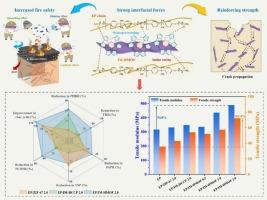磷/氮功能化配体的层状mof增强环氧树脂的防火安全性和力学性能
IF 8.1
2区 材料科学
Q1 ENGINEERING, MANUFACTURING
Composites Part A: Applied Science and Manufacturing
Pub Date : 2025-08-08
DOI:10.1016/j.compositesa.2025.109233
引用次数: 0
摘要
环氧树脂(EP)固有的易燃性和脆性严重制约了其在先进制造业中的应用。本研究提出了一种新的方法,通过结合磷/氮基咪唑(IM-HCCP)衍生的层状金属有机框架结构(IM-HMOF)来提高EP的防火性能和机械性能。IM-HMOF通过咪唑基团和P=N-杂环结构提供了双交联位点,有效调节了与EP基体的界面相互作用,对EP复合材料的力学性能和热性能产生了积极影响。EP/IM-HMOF 2.0的拉伸模量、拉伸强度和断裂伸长率分别比纯EP提高了54.8%、102.5%和47.1%。此外,IM-HMOF的加入显著降低了EP基质的热分解速率,提高了炭产率,使EP复合材料具有优异的热性能。EP/IM-HMOF 2.0的火灾危险性最低,峰值放热率、峰值产烟率、峰值CO产出率和峰值CO2产出率分别降低42.4%、34.0%、40.6%和43.5%。这与层状mof的阻隔效应以及Co-P-N阻燃体系的催化、自由基捕获和可燃稀释效应有关。本研究提出了一种在分子水平上赋予EP阻燃和增韧性能的创新策略,这有助于打破聚合物应用的局限性。本文章由计算机程序翻译,如有差异,请以英文原文为准。

Lamellar MOFs from phosphorus/nitrogen-functionalized ligands for enhanced fire safety and mechanical properties of epoxy resin
The inherent flammability and brittleness of epoxy resins (EP) impose significant constraints on their application in advanced manufacturing. Herein, this work presented a novel approach to improving the fire protection and mechanical performance of EP by incorporating lamellar metal organic framework architectures (IM-HMOF) derived from phosphorus/nitrogen-based imidazole (IM-HCCP). The IM-HMOF provided dual crosslinking sites through imidazole groups and P=N- heterocyclic structure, which effectively regulated the interfacial interactions with the EP matrix and positively affected the mechanical and thermal properties of EP composites. Specifically, the tensile modulus, tensile strength and elongation at break of EP/IM-HMOF 2.0 were enhanced by 54.8 %, 102.5 % and 47.1 %, respectively, compared with pure EP. Additionally, the addition of IM-HMOF significantly reduced the thermal decomposition rate of the EP matrix and increased char yield, which conferred excellent thermal properties to the EP composites. Notably, the EP/IM-HMOF 2.0 had the lowest fire hazards, with a reduction of 42.4 %, 34.0 %, 40.6 % and 43.5 % in the peak heat release rate, peak smoke production rate, peak CO production rate and peak CO2 production rate, respectively. This was associated with the barrier effect of lamellar MOFs, as well as the catalytic, radical trapping and combustible dilution effects exerted by the Co-P-N flame retardant system. The present work proposes an innovative strategy at the molecular level to endow EP with both flame retardant and toughening properties, which helps to break the limitations of polymer applications.
求助全文
通过发布文献求助,成功后即可免费获取论文全文。
去求助
来源期刊

Composites Part A: Applied Science and Manufacturing
工程技术-材料科学:复合
CiteScore
15.20
自引率
5.70%
发文量
492
审稿时长
30 days
期刊介绍:
Composites Part A: Applied Science and Manufacturing is a comprehensive journal that publishes original research papers, review articles, case studies, short communications, and letters covering various aspects of composite materials science and technology. This includes fibrous and particulate reinforcements in polymeric, metallic, and ceramic matrices, as well as 'natural' composites like wood and biological materials. The journal addresses topics such as properties, design, and manufacture of reinforcing fibers and particles, novel architectures and concepts, multifunctional composites, advancements in fabrication and processing, manufacturing science, process modeling, experimental mechanics, microstructural characterization, interfaces, prediction and measurement of mechanical, physical, and chemical behavior, and performance in service. Additionally, articles on economic and commercial aspects, design, and case studies are welcomed. All submissions undergo rigorous peer review to ensure they contribute significantly and innovatively, maintaining high standards for content and presentation. The editorial team aims to expedite the review process for prompt publication.
 求助内容:
求助内容: 应助结果提醒方式:
应助结果提醒方式:


